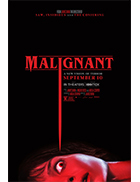Malignant
|  Note: This review contains some major spoliers. Proceed with caution if you have not yet seen the film. The thing I most appreciate about James Wan’s new horror-thriller Malignant is how much its effectiveness banks on the audience’s (mis)understanding of what to expect from a new James Wan horror-thriller. Although he first made his name with the grisly-gory Saw (2004), he became an established fixture of the horror genre with a series of well executed, stylish, and effective supernatural thrillers: Dead Silence (2007), Insidious (2010), The Conjuring (2013), Insidious: Chapter 2 (2013), and The Conjuring 2 (2016). In recent years, he moved away from horror, tackling the action sequel Furious 7 (2015) and the DC Comics’ tentpole Aquaman (2018), so news that he was returning to the genre that made his career only heightened the expectation that Malignant would be a return to form. And it is … sort of. In the first half of Malignant, Wan does everything in his power to convince us that we are back in familiar supernatural territory. We open with a disturbing prologue set in an isolated research hospital in which one of the patients, who harbors the supernatural ability to control electricity and broadcast his thoughts to electronic devices, goes berserk and slaughters a whole bunch of doctors and nurses. After that we jump forward several decades and are introduced to Madison Mitchell (Annabelle Wallis), a meek young woman married to an abusive husband (Jake Abel) who resents her for her many miscarriages (she is pregnant again). They live in a large, Victorian-style house in Seattle that appears to be the home of a shadowy entity that emerges from the dark one night and slaughters Madison’s husband and attacks her, sending her to the hospital with yet another miscarriage. She returns home under the watchful eye of her caring sister, Sydney (Maddie Hasson), but she soon discovers that she is cursed with visions in which she sees, but is helpless to stop, further violent attacks by the entity, which we see as a long-limbed, long-haired monstrosity with a skull-like visage. She tries to tell the investigating police detectives, the sympathetic Kekoa Shaw (George Young) and the cynical Regina Moss (Michole Briana White), about what is happening, but they are skeptical, at best. Meanwhile, the mysterious entity’s victims list grows to include a tour guide of the Seattle Underground (Jean Louisa Kelly) and two of the doctors we saw in the prologue, which suggests an obvious connection, although not the one you might suspect. Screenwriter Akela Cooper (Hell Fest, The 100), working from a story co-concocted by Wan and his wife, the actress Ingrid Bisu, flips the script halfway through when it is revealed that the entity is, in fact, Madison herself and that it was she we saw in the hospital-set opening prologue. In a delightfully twisted turn of events, we learn that Madison had a conjoined, deformed twin attached to her back that was (mostly) removed via surgery, although the face and head, which was connected to the back of her skull and interwoven into her brain, couldn’t be removed and therefore was simply pushed into the back of her skull and sealed up. This twisted twin remained dormant for years until one of her husband’s violent attacks awoke it, after which it started taking over her body and using it to enact revenge. The uncanny nature of this twin’s physical and psychic co-existence with Madison is a Freudian’s delight, and Wan gets all the mileage he can from the extremely unsettling imagery of Madison walking backwards, her twin’s skull-like face pushing itself out through a seam in the back of her skull. Of course, it barely makes any sense when you stop and think about it for more than half a second, but that doesn’t really matter because Wan is much more interested in simply allowing the story, which you were led to believe was another supernatural tale of haunting and possession, lurch off into the realm of the utterly, deliriously bizarre. His willingness to subvert his own brand is admirable, and I appreciated the way he allows the whacked-out premise to play itself out into pure gonzo glory. Wan’s recent submersion in action and fantasy has clearly affected him, though, and if Malignant has a flaw, it is that it clumsily morphs into Matrix-style action in its last quarter, particularly in a sequence when Madison’s twin uses her to essentially take out an entire police station. It is a pulpy action scene that works on its own merits, but it feels out of place here. Malignant’s best moments play up its uncanny horrors and visceral shocks in ways that are delightfully unexpected. Copyright © 2021 James Kendrick Thoughts? E-mail James Kendrick All images copyright © Warner Bros. / New Line Cinema |
Overall Rating: 

 (3)
(3)


